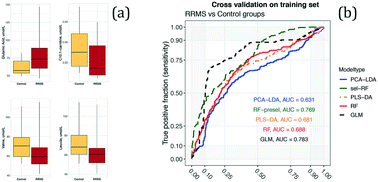Targeted metabolomics approach for identification of relapsing–remitting multiple sclerosis markers and evaluation of diagnostic models†‡
Abstract
Multiple sclerosis (MS) is an inflammatory autoimmune disease that causes demyelination of nerve cell axons. This paper is devoted to the study of relapsing–remitting multiple sclerosis (RRMS) biomarkers using an LC-MS/MS-based targeted metabolomics approach and the assessment of changes in the profile of 13 amino acids and 29 acylcarnitines in plasma during the relapse of the disease. A significant increase (p < 0.05) in the concentration of glutamate in plasma in patients with RRMS was detected, while the sum of leucine and isoleucine was reduced. A decrease in the concentration of decenoylcarnitine (C10:1, p < 0.05) was observed among acylcarnitines, and this metabolite was detected as a biomarker for the disease for the first time. Several models based on a single marker or multiple pre-selected markers and multivariate analysis with a dimension reduction technique were compared in their effectiveness for the classification of RRMS and healthy controls. The best results for cross-validation showed models of general linear regression (GLM, AUC = 0.783) and random forest model (RF, AUC = 0.769) based on pre-selected biomarkers. Validation of the models on the test set showed that the RF model based on selected metabolites was the most effective (AUC = 0.72). The results obtained are promising for further development of the system of clinical decision support for the diagnosis of RRMS based on metabolic data.



 Please wait while we load your content...
Please wait while we load your content...